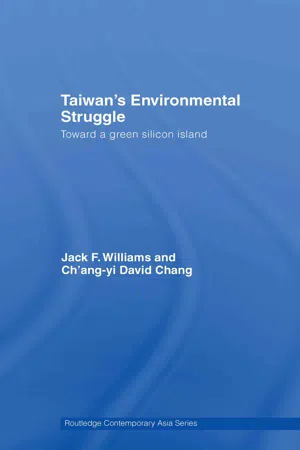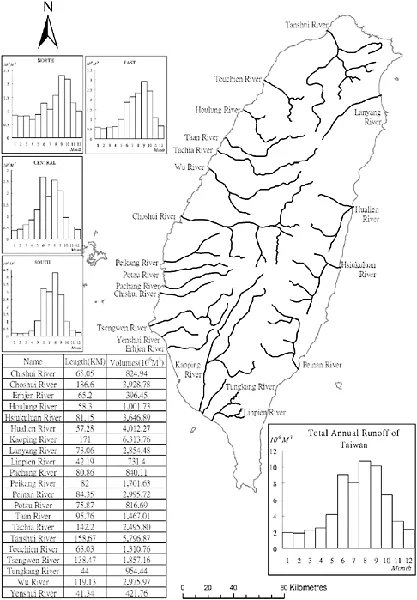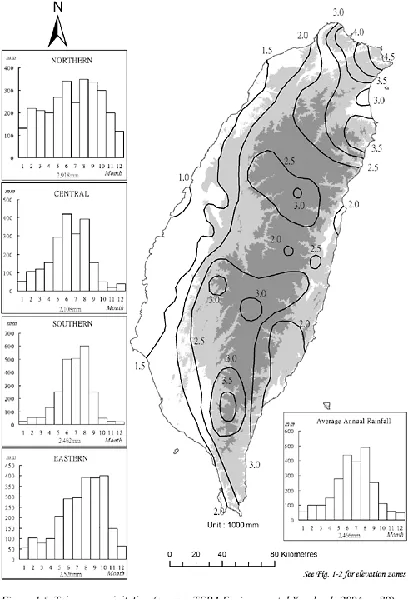![]()
1
A crowded island
Taiwan’s environmental setting
When Chen Shui-bian was running for President in the late 1990s, he and his Democratic Progressive Party (DPP) chose the slogan ‘Green Silicon Island’ to symbolize what they stood for and hoped to achieve if they came to power in Taiwan. The ‘green’ represented not only purity of purpose and principles but also an environmentally restored and sustainable Taiwan. The ‘silicon’ stood for the silicon chip, the basic electronic device on which Taiwan’s highly successful information technology economy was based. The DPP was claiming, in effect, that it would do all in its power to maintain Taiwan’s remarkable economic progress within an environmentally sustainable system. It was a noble goal to aim for and it is likely that it won over some voters. Have they succeeded? Not by a long shot, at least not yet. Creating a Green Silicon Island will take much longer than a mere decade, and require the talents and commitment of many people beyond just the DPP. Taiwan has major hurdles to overcome to reach that seemingly utopian goal.
From an environmental perspective, Taiwan not only ranks as one of the more polluted places on earth, it also has a unique mix of factors that account for the island’s relatively weak standing on the environmental front. Taiwan’s environmental problems derive from several fundamental realities:1 (1) The island is relatively small in proportion to its population (Figure 1.1). Hence, the impact of humans upon the environment is more intense than in less densely populated places. (2) The island experienced a highly successful economic transformation in the last half century that produced one of Asia’s genuine ‘miracles’ of modern development, in terms of improvement in per capita income and overall quality of material well-being for its citizens. The process, though, involved rapid industrialization and urbanization, and high mass consumption, that inevitably resulted in rapid escalation in degradation of the island’s fragile air, water, and land, and by the 1980s produced some of the worst environmental pollution to be found anywhere in Asia. (3) The island suffered for more than 40 years under an authoritarian one-party government that ran the island virtually unchecked in terms of development policies and allocation of the island’s resources. The result was that abuses to the environment were buried under the rhetoric of higher priorities in the government’s ongoing struggle with the Chinese government in Beijing. In short, the environment had to wait. Now, in
the last 10–20 years, under a new political system, Taiwan has been scrambling to catch up, to make amends and redress past abuses to the environment. The struggle has not been easy.
Taiwan, of course, is not alone in the world in having had these distinctive characteristics and experiences in the last half of the twentieth century. Many states are small, with high population densities.2Many have experienced rapid economic growth, while simultaneously seeing their environmental quality decline. Many have undergone periods of repressive political systems. South Korea is the one Asian state that perhaps has most closely paralleled the experience of Taiwan. Yet, there have been important differences between the story of Taiwan and that of South Korea (and other states). It would not be hyperbole to say that Taiwan is truly unique in modern Asia in the ways in which geography, economy, and politics have interwoven and interacted to produce the present environmental status of the island. What follows is the story of Taiwan and its environmental struggle.
Role of geography3
Taiwan’s enormous geopolitical and economic importance in contemporary East Asia has a tendency sometimes to make one imagine that the island is much larger than in actuality. Taiwan has a total area of just under 36,000sq.km, and is shaped somewhat like a tobacco leaf, running about 144km at the widest point and 394km in length (Figure 1.2). This makes it about half the size of Ireland, or nearly the size of the Netherlands or Switzerland.4On this island live a total of approximately 23 million people. Even if all of these people were evenly distributed over the island, Taiwan still would have one of the world’s highest population densities. However, the distribution actually is highly skewed.
Taiwan is a geologically youthful, very mountainous island, dominated by a massive tilted fault block running north-east to south-west along the entire length of the island. More than 200 peaks rise to elevations over 3,000 metres. The highest peak, Yu Shan (literally ‘Jade Mountain’, a.k.a. Mount Morrison), reaches just under 4,000 metres (higher even than any mountain in Japan, including Mount Fuji). The slopes of this spine are steepest on the east, where mountains rise directly out of the sea in some places, resulting in limited level lowlands for human habitation. Thus, still today there are less than one million people living along the entire eastern side of the island. Erosion over geologic time has produced short, steep, shallow rivers flowing out of the mountain centre. Those flowing to the west produced a relatively wider coastal plain facing the Taiwan Strait and China along the entire western side of the island (Figure 1.3).
The bulk of the 23 million people (and most of the modern economy) reside there. In all, lowlands are in short supply. Alluvial plains below 100 metres occupy less than a third of the island. Hence, when referring to population density, it is more accurate to observe that Taiwan’s people are actually occupying a land area slightly smaller than the US state of Delaware, or about half the size of Massachusetts. For the total land area, Taiwan’s population density is already 622 persons per km2, second highest in the world after Bangladesh, but greater than that of the Netherlands, with which the island is often compared, and more comparable to that of Japan, where lack of lowlands and unusual
urban distribution patterns also produce among the world’s highest population densities. Taiwan’s real population density, however, based on the actual land area occupied by most of the people, is closer to 2,500 persons per km2. Further, in the major metropolitan areas of Taipei and Kaohsiung, the density soars to nearly 10,000 per km2 (Figure 1.4). Under such high population
density, it should be no surprise to find Taiwan has serious environmental imbalances.
Those imbalances are made worse by other aspects of Taiwan’s geographical setting. The island straddles the Tropic of Cancer, or northern margin of the subtropical belt in East/Southeast Asia, between roughly 21° and 25° N. Lat., about the same latitude as the island of Cuba. Lying just off the south-east coast of China, though, means that Taiwan gets some continental influence, especially during the winter monsoon, and hence the northern half of Taiwan is relatively cool to mild in winter. Still, there is no frost in the lowlands (but there is occasional snowfall in the highest mountain elevations in winter), and hence a year-round growing season. Agriculture thus is intensive, with the need to eke as high yields as possible out of limited farm fields. Rainfall is abundant because of the subtropical monsoonal climate, albeit with distinct variations in rainy periods over the area of the island, November to February generally being the driest period. Annual precipitation is highest in the central mountains and north-east, where up to 3,000mm5 are normal. The mean for the entire island is about 2,500mm (Figure 1.5). Yet, water shortages have actually become a reality in recent decades, especially in times of periodic droughts, because of so many people, a highly urbanized, water-thirsty economy, plus rapid run-off of surface water. The building of dams and water reservoirs thus has been a priority of governments since the Japanese era, but demand for water seems to grow faster than supply. Unfortunately, Taiwan also lies in the typhoon zone of Southeast and East Asia, and periodically suffers direct hits by devastating typhoons that sweep up out of the south-west Pacific and rake the Philippines and areas to the north, especially in late summer/early autumn. These systems can bring destructive winds and immense rainfall that produce serious erosion and flooding problems, as well as loss of property and lives. In short, water is a precious commodity with sometimes too much and sometimes too little, and hence there is a real need to use it wisely.
Lush natural vegetation, and some of the most beautiful virgin forest cover left in Asia, have felt the pressure of high population density and economic demands for forest products and use of marginal slopelands for agriculture and tourism. Not many people live in the uplands and mountains of Taiwan, but there is no mistaking the impact of humans on that major realm of the island. Compounding all of this is the island’s location on the circum-Pacific ‘Ring of Fire’, or tectonically active zone that follows the junctions of the continental plates all around the Pacific Rim. The result is frequent earthquakes whose impact is magnified by high population density, steep slopes, and often improper use of slopelands. The September 1999 quake in central Taiwan was the most recent devastating earthquake to hit Taiwan, causing massive destruction and heavy loss of life and injuries.6
Earthquakes, typhoons, and floods are natural calamities that humans have no power to prevent, of course. But in a high population density island such as Taiwan, the government and people have an obligation to do all that is humanly possible to design the layout of cities, transportation networks, and economic
systems to try to minimize the impact of such calamities when they occur. Unfortunately, this has not always been the case in Taiwan, and there is much that remains undone in terms of protecting Taiwan and its people from the devastation of natural calamities.
Role of the economy
Taiwan’s dramatic transformation from a primarily agricultural colony of Japan in 1945 to one of the most powerful industrial economies of Asia by the end...





